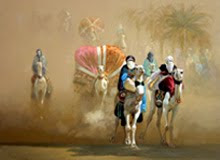Sunday, May 2, 2010
How to ride a camel
Riding a camel is different from riding a horse or most any other four-legged creature.
They Are Mean.They Spit.They Smell.
But humans have been riding camels to get from hither to yon since long before recorded time. And if riding a camel is one of those Bucket List things to do in life, it might as well be done right.
How to ride a camel is different than how to ride a horse.
The problem with camels, besides their disposition, their body odor and tendency to expectorate unexpectedly, is the way they walk.
Horses, for example, lift a left front hoof as they lift a right back hoof, and so on. This keeps the center of gravity on the horse's back somewhat stable.
Camels, on the other hand, lift both front and back hooves of the left side, then front and back of the right side. This creates a very powerful swaying motion from right to left. Considering that most camels are about 6.5 feet (2 meters) tall, and the passenger sits on top of the hump, which is another 12 inches (30 cm) upward, that's a lot of motion high in the sky.
Getting on the Camel
Before riding a camel, one must actually get on the critter. The nice thing is that they will kneel down on their knees, if asked nicely. But there's still about four feet of camel hump and a saddle horn to swing a leg over. There are no stirrups on the saddle for the rider to place a foot and get that extra boost. It's an awkward position, particularly for shorter people. Thankfully, most camel owners will bring a small step stool and help those who have trouble getting on.
How to Sit on the Camel
The tendency for most inexperienced riders is to straddle the camel like a horse. Don't do that. Once on the saddle, grab the front horn tightly and draw knees up to a 90 degree bend. That bend provides additional balance and support to the rider as the camel rises to his feet and begins his swaying movements.
After the rider becomes adjusted to the sway and motionof the camel and the ride begins, the rider should throw one leg forward over the camel's neck. That will ease pressure on the lower back and hips as this 600 pound animal makes his way across the sand. Take a look at the locals riding camels. That's how they are doing it.
Getting Up and Down
The scariest part of the camel ride is when he gets up and down on his knees. Although the camel's movements are very slow and gentle, the rider is nonetheless pitched forward at about a 45 degree angle. Don't scream. That will be embarrassing.
But don't fall off either. That's even more embarrassing. The rider should continue to grip the camel's sides firmly with the knees and hang on to the saddle horn. If the camel is leaning forward, the rider should lean backward. If his behind is coming up last, the rider should lean forward. And hang on tight. It only lasts a few seconds.
Subscribe to:
Post Comments (Atom)



No comments:
Post a Comment